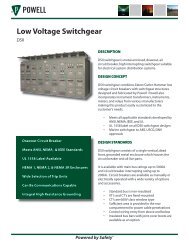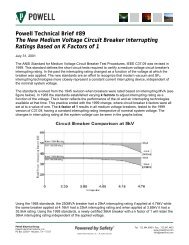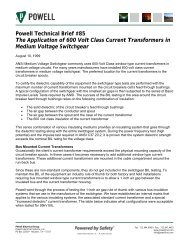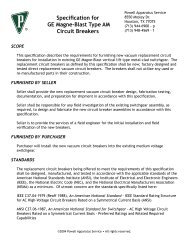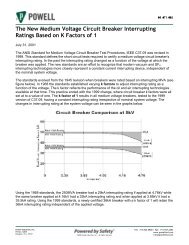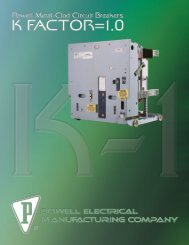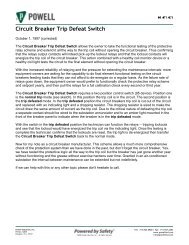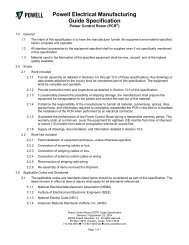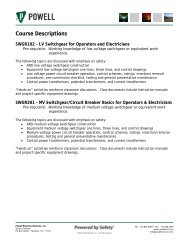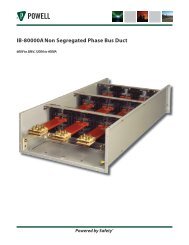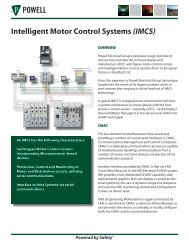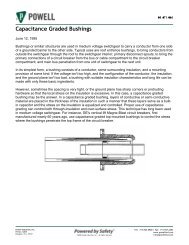IB-DU1000 Metal-Enclosed Bus - Powell Industries, Inc.
IB-DU1000 Metal-Enclosed Bus - Powell Industries, Inc.
IB-DU1000 Metal-Enclosed Bus - Powell Industries, Inc.
You also want an ePaper? Increase the reach of your titles
YUMPU automatically turns print PDFs into web optimized ePapers that Google loves.
<strong>Metal</strong>-<strong>Enclosed</strong> <strong>Bus</strong><strong>IB</strong>-<strong>DU1000</strong>C. AlignmentThe entire run of bus duct should be installed andadjusted at all terminal equipment BEFORE finaltorquing and insulation of bus conductor joints.Adjustments to obtain proper alignment should bedistributed evenly throughout the bus system atevery splice. Normally it is not required but a smallamount of additional adjustment can be obtained byrepositioning end flanges.D. AssemblyInstallation drawings contain the construction andassembly details of standard components.It is important that assemblies be correct in allrespects. Small details such as the position andorientation of spacers and bolting hardware must beobserved. Proper torque procedures help insure atrouble free installation and service life.The contact surfaces of all electrical joints areeither silver or tin plated. The use of electrical jointcompounds is neither required nor recommended.Contact surfaces should be cleaned before assembly.A mild non-metallic abrasive may be used to loosendirt or other contaminants.Each assembly should be cleaned and inspectedas it is completed. Any shipping fixtures must beremoved. SEE THE CAUTION REGARDING STRAIGHTSECTIONS UNDER THE SECTION ON “ERECTION”. Theshipping fixture used on misalignment and vibrationcollars should not be removed until these sections areinstalled or protected from damage.The components necessary to complete theinstallation at each bus end (or splice) have beenshipped in separate identified packages.The bus housings must be properly grounded.Since the type and number of facilities required toestablish adequate grounding can vary considerablyfor different situations, the responsibility for thedesign, installation, & verification of the ground cannot be assumed by Delta/Unibus. Ground pads, withor without cable lugs, can be provided on the bushousings at convenient locations for connectionto station ground. The bus housing can be used toestablish ground continuity in many applications. Itis important that the housing splice plates whichare designed to provide a low resistance connectionbetween adjacent bus sections be properly installed.A continuous insulated or multigrounded copperor aluminum ground bar is also an available option.Flexible ground continuity connections which areprovided at bus expansion joints should be inspectedfor tightness or damage.After the installation is complete, the bus insulationshould be checked from phase-to-phase and phaseto-groundusing a 1000 volt megger.Control wiring, such as instrument transformersecondary circuits, space heater wiring, thermostatcircuits, etc. are subjected to a factory overpotentialtest to ground of 1500 volts, 60 HZ, for one (1) minute.This test should be repeated on the completedinstallation.Perform the AC high potential test as described underField Testing.The entire bus system should be carefully examinedfor any indication of physical damage. Touch up paintshould be applied to any finish surfaces which havebeen damaged. Avoid excessive accumulation oftouch up paint on breathers. Verify that painting hasnot clogged any breathers.It is important that during installation all thenecessary actions are taken to protect the bus fromthe weather and the abnormal entry of dirt or othercontaminants. The space heaters should be put intooperation as soon as practicable.Powered by Safety ®




